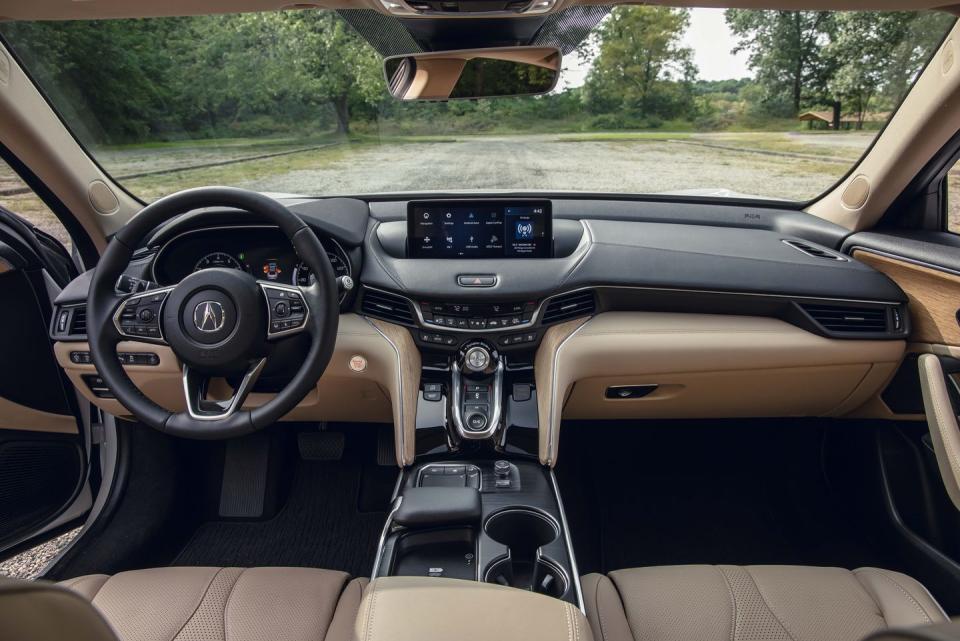Tested: 2021 Acura TLX Shows Signs of Greatness

10/1/20 UPDATE: This review has been updated with test results for the 2.0T SH-AWD model.
It's been a while since Acura built a worthy sports sedan. Although the TL and TSX earned comparison-test victories in their day, merging the two to create the tweener 2015 TLX failed to capture the magic of either. Meanwhile, Acura's other sedan, the Honda Civic–based ILX, has withered on the vine, and when the 11th-gen Civic debuts in the coming months, the ILX will be two whole Civic generations behind.
It's a good thing that the new TLX is an extremely credible and full-fledged effort. Parked next to a BMW 3-series, the TLX looks supercar wide, backing up Acura's boasts about the width and low roofline of its new sedan. Compared with the Bimmer, it has an extra 3.3 inches between its flanks. It's also 8.9 inches longer.

That added width isn't just for your eyeballs; it's for your elbows and hips, too. Interior room up front is generous, with lots of space between the driver and passenger. The cabin also shows off real wood or textured aluminum trim. But the larger footprint brings with it that universal enemy of performance: weight. At 4026 pounds, our top-trim TLX Advance with the optional SH-AWD is more than 300 pounds heavier than a 330i xDrive and some 600 pounds heavier than a Honda Accord.
Yet, despite its size, the TLX's rear-seat accommodations are on the small side for a luxury compact sedan. But Acura has a reasonable explanation: Consumers' widespread migration to crossovers gave the development team the courage to sacrifice interior space on the altar of beauty, as everyone who's shopping for maximum practicality has already moved on to an SUV.

The chassis is also a major differentiator. Set up and engineered for the handling needs of the performance-focused Type S model that will launch in spring of 2021, the structure is stiff, with perfectly dialed-in chassis tuning. TLX Advance models feature adaptive damping and a handful of driving modes, but the Comfort and Normal settings have too much float. The base car's nonadjustable suspension tuning strikes us as just right. Remember when BMWs used to have one excellent setup? The regular TLX is like that.
Laying the Groundwork
Building a great-driving car starts with a firm foundation of stampings, castings, and extrusions. Acura's TLX benefits from an overhauled architecture, designed with the fortitude to make the high-performance Type S work. No chassis parts are shared with the Honda Accord, which is built in the same Ohio assembly plant. Lengthening the distance between the dash and front axle yields almost rear-drive proportions. Only the longish front overhang hints at the transverse-engine, front-drive setup. The control-arm front suspension is a return to Acura sedans of the past, and it's a claimed 85 percent stiffer laterally than the last TLX's strut setup. The rear suspension gains a link (to five total) for better wheel control; lateral stiffness is up 45 percent. Under hood, the four-cylinder sits so far ahead of the axle, it looks as if you could remove the steering rack from above. That extra room is to accommodate the TLX Type S's turbo V-6. The battery moves to the rear for the first time in an Acura, shifting a claimed 52 pounds to the tail, while the use of aluminum for the front fenders and shock towers removes 29 pounds from the nose. Acura says the center of gravity shifts 3.4 inches rearward. Our all-wheel-drive test car had a 57.2/42.8 percent front/rear weight distribution.

Far More Expensive, but Still a Bargain
The price is up $4500, but the TLX's $38,525 entry point is still $3720 less than a 3-series'. Add $2000 if you want all-wheel drive. At launch, the TLX gets a transversely mounted 272-hp turbocharged 2.0-liter inline-four from the RDX and Honda's 10-speed automatic. It's a satisfying powertrain, and the electronically enhanced engine noises are natural-sounding and pleasing, which isn't the norm.
The fourth generation of Acura's Super Handling All-Wheel Drive (a.k.a. SH-AWD) reacts quicker and with more available rear bias than the last, and you can feel the system tightening your line during vigorous cornering as it overdrives the outside rear tire. The 10-speed serves admirably across the Honda and Acura lineups, but the programming and responses aren't much different here than they are in, say, an Odyssey minivan. And its lazy reaction to paddle inputs and refusal to hold gears stand out as detriments. The brakes are the same system used in the NSX but with slightly less aggressive tuning. The pedal is firm and easy to modulate, unlike some similar “by-wire” systems.

In a drag race, the TLX can't hang with the quick end of the segment, and annoyingly, it's not as swift as its little brother, the Accord 2.0T. Acura fits the TLX's 19-inch wheels that come on everything but the base model with Michelin's Primacy A/S, a tire chosen not for its grip but probably its long tread wear, ride comfort, low noise, and minimized rolling resistance. Although the steering is quicker than before, and with progressively wider gear-tooth spacing so the response quickens as you turn the wheel off-center, turn-in is dull, and the tires squeal even at responsible street speeds. On the skidpad, an Accord Sport on narrower but more aggressive all-season tires outperforms the TLX, 0.89 g to 0.87 g. And the setup hurts the Acura's stopping distances: Both the 70-mph and 100-mph braking figures are a ways off from those of the summer-tire-wearing segment leaders.
Acura's choice of a laid-back tire is a shame, as the dialed-in chassis is begging for more grip. Torsional rigidity is up by a claimed 50 percent, and you can feel it. There's greatness in the latest TLX, but it's going to take the Type S's 355-hp turbocharged V-6 and 20-inch Pirelli P Zero PZ4s to fully realize it.
You Might Also Like

 Yahoo News
Yahoo News 